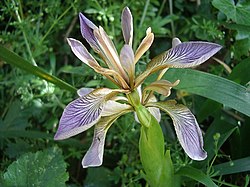| Iris foetidissima | |
|---|---|
 | |
| Flower | |
| Scientific classification | |
| Kingdom: | Plantae |
| Clade: | Tracheophytes |
| Clade: | Angiosperms |
| Clade: | Monocots |
| Order: | Asparagales |
| Family: | Iridaceae |
| Genus: | Iris |
| Subgenus: | Iris subg. Limniris |
| Section: | Iris sect. Limniris |
| Series: | Iris ser. Foetidissimae |
| Species: | I. foetidissima |
| Binomial name | |
| Iris foetidissima | |
Iris foetidissima, the stinking iris, [1] gladdon, Gladwin iris, roast-beef plant, or stinking gladwin, is a species of flowering plant in the family Iridaceae, found in open woodland, hedgebanks and on sea-cliffs.
Its natural range is Western Europe, including England (south of Durham) and also Ireland, and from France south and east to N. Africa, Italy and Greece. [2]

It is one of two iris species native to Britain, the other being the yellow iris ( Iris pseudacorus ).
It has tufts of dark green leaves. [1] Its flowers are usually of a dull, leaden-blue colour, or dull buff-yellow tinged with blue. The petals have delicate veining. It blooms between June and July, but the flowers only last a day or so. [3] The green seed capsules, which remain attached to the plant throughout the winter, are 5–8 cm (2–3 in) long; and the seeds are scarlet.
It is known as "stinking" because some people find the smell of its leaves unpleasant when crushed or bruised, [1] an odour that has been described as "beefy". Its common names of 'gladdon' and 'gladwyn' or 'gladwin', are in reference to an old word for a sword, (Latin 'gladius') due to the shape of the iris's leaves. [3]
This plant is cultivated in gardens in the temperate zones. Both the species [4] and its cultivar 'Variegata' [5] have gained the Royal Horticultural Society's Award of Garden Merit. [6]